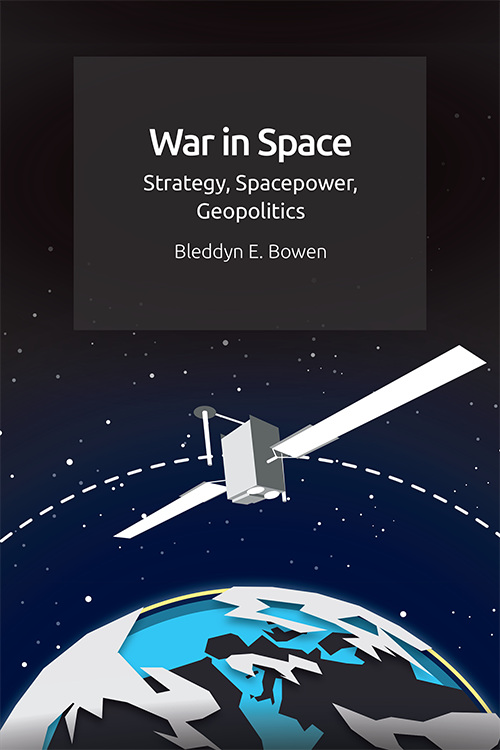
by Bleddyn E. Bowen
To mark the release of War in Space: Strategy, Spacepower, Geopolitics in paperback, this blog post is an edited extract of the book, summarising the seven propositions of spacepower theory from the book to guide critical thought and education about the use of military power as many military forces contemplate the use of space warfare in future military campaigns.
You can also watch a short video summary of the book here:
The seven propositions are:
I. Space warfare is waged for the command of space
II. Spacepower is uniquely infrastructural and connected to Earth
III. The command of space does not equate to the command of Earth
IV. The command of space manipulates celestial lines of communication
V. Earth orbit is a cosmic coastline suited for strategic manoeuvres
VI. Spacepower exists within a geocentric mindset
VII. Spacepower is dispersed and imposes dispersion on Earth
Proposition I established that acts of space warfare must contribute to a command of space, which can constitute controlling space infrastructure and/or denying its use. That command of space in turn must serve terrestrial political goals for those who possess it. Any tactical action must contribute to something on the strategic level to meet political goals on Earth, otherwise it is a mindless act of wanton violence and destruction. The command of space is subordinated ultimately to the objectives of grand strategy. Space warfare is the continuation of Terran politics by other means; acts of space warfare do not suspend political intercourse or change the conduct of politics into something entirely different.
Proposition II articulated the need to grasp the unique attributes of the Earth orbit environment, how spacepower as we know it is infrastructural in its primary quality (as opposed to combat-platform centric) and is not isolated from Earth. Proposition II argues that despite the initial conceptual resonance between seapower and spacepower regarding commanding a transitory medium, space is a unique geography in its use as supporting infrastructure. That said, outer space is not isolated from Earth as is sometimes done in spacepower literature, and what goes on in space is always relative to what happens on Earth.
Proposition III pushes against the notion that commanding space would lead to a domination of Earth, and an excessive focus on seeking battle or the destruction of space systems as an axiom for strategists and war planners who often seek the enemy’s centre of gravity. Victorious battles and dominant command should not be viewed as inherently decisive. This questions many assumptions or beliefs of outer space as the ‘ultimate high ground’ and the uncritical transposition of ‘decisive’ naval battles to anti-satellite operations.
Proposition IV details how celestial lines of communication knit together the components of space infrastructure and where and how commanding space can be achieved by prioritising chokepoints and high-value positions in Earth orbit and from Earth’s surface. These first four propositions moderated existing spacepower theories, often drawn from bluewater seapower theories, conjuring the notion of Earth orbit as analogous to an expansive ocean and providing the necessary foundation for the following propositions.

Proposition V projects an analogy of Earth orbit as a cosmic coastline where Earth orbit and the surface are littoral zones where strategic manoeuvres are required to tap into the more subtle supporting effects of spacepower. It breaks new ground in spacepower theory by theorising the bulk of activities that defines spacepower as we know it – the deployment, use and management of satellites and their services and data. Proposition V geographically contextualises the first four propositions into a coastal, rather than bluewater–oceanic, analogy to Earth orbit. Earth-bound space powers look up to outer space and satellites for support or prepare for threats to their terrestrial operations from the ‘orbital flank’. Spacepower and operations in Earth orbit must be seen as primarily a supporting force or capability, not a direct war-winning capability or a scene dominated by spectacular battles.
Proposition VI continues this continental analogy by theorising the cultural aspects of spacepower in a geocentric reality – what happens in space is only relevant in how it affects Earth. This geocentrism means that terrestrial threats and perspectives tend to override space-centric ones. ‘Space forces’ may struggle to win bureaucratic and resource struggles against terrestrial counterparts. As space is perceived as a secondary theatre, and not as essential or pressing as terrestrial ones, advocates of spacepower within states may struggle to fight for their corner in bureaucratic politics and resource allocation. Naval cultures suffer such problems in states like France, Russia and India, and in terms of spacepower every space-faring state is Earth-based, and therefore geocentric.
Proposition VII brings the theory to a head by drawing out the ‘so what’ from the strategic level and more abstract discussions of spacepower. It theorises the influence of spacepower on modern warfare as a dispersing influence, continuing a long trend of increasing firepower coordination capabilities with an ever-increasing battlefield size. Concentration and dispersal are still relevant concepts for studying war in the age of the hostile celestial coastline, but the ways of achieving them are changing. This influence of spacepower on modern warfare raises the importance of commanding space in the first place, bringing the reader full circle back to Proposition I.
The seven propositions demonstrate how two competing strategies for space warfare rest upon a tension between when to exploit and when to deny the dispersing effects of spacepower, and portrayed those strategies as possibilities and ideals, rather than inevitabilities.
Want to keep up to date on our latest Politics books? Sign up to our mailing list.
About the book
Applies strategic theory to outer space and drawing out the implications for international relations
- Offers a definitive and original vision of space warfare that theorises often-overlooked aspects of contemporary space activities based in the discipline of Strategic Studies
- Draws out the implications of spacepower for wider debate in grand strategy and IR
- Applies the theory in a topical and contentious area within contemporary grand strategy – anti-access and area-denial warfare in the Taiwan Strait between China and America
- Summarises key principles in 7 propositions to make the key take-aways of theory applicable and memorable for researchers and practitioners
To celebrate the release of the paperback, we are offering a 30% discount. Use the code PAPER30 at checkout. Pre-order.
About the author

Bleddyn Bowen is a Lecturer in International Relations at the University of Leicester. He is an established expert in strategy, space warfare and the military uses of outer space. His work has been published in a number of key journals, including The Journal of Strategic Studies, The British Journal of International Relations, Astropolitics, and the RUSI Journal. Bleddyn frequently contributes to news broadcasting and professional blogs and convenes the Astropolitics Collective research group.






